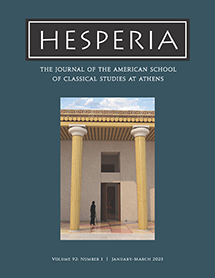Hesperia 92.1 Now Online!

We are pleased to announce the publication of Hesperia 92.1! Topics in this issue include a reexamination of Middle Helladic Greek settlements and Middle Bronze Age synchronisms using Gray Minyan pottery, a reconstruction of the Palace of Nestor at Pylos, and a reconsideration of the Mycenaean Fountain on the Athenian Acropolis, originally excavated in 1937 and 1938.
Subscribers can read the issue online at Project MUSE, which now hosts current issues of Hesperia as well as an archive of past volumes dating to 2002. Hesperia remains on JSTOR as part of their Arts and Sciences II package, with the usual three-year moving wall. Additionally, all issues of Hesperia from 2011 and earlier are available as Open Access on our website. The printed version will be mailed shortly.
Gray Minyan in the Middle: Reconsidering Central Greek and Cycladic Middle Bronze Age Synchronisms, by Christopher Mark Hale, details how an emerging understanding of Middle Helladic Gray Minyan pottery development in central Greece allows for a reconsideration of relative synchronisms between the region and the Cyclades. Updated comparisons indicate that Ayia Irini period IV on Kea was resettled no earlier than the middle of Middle Helladic II in central Greece, not the beginning as previously presented. In addition, comparisons with more distant Cycladic sites, such as Phylakopi, Akrotiri, and Paroikia, add evidence for central Greek and Cycladic interaction prior to the resettlement of Ayia Irini IV. As detailed in the article, such adjustments have important implications for our understanding of Kea and Ayia Irini, broader interregional interaction, and the overall Aegean Middle Bronze Age relative chronological framework.
The Palatial Megaron and Upper Story in the Palace of Nestor: Evidence for a New Reconstruction, by Shannon LaFayette Hogue, examines a group of previously unpublished floor plaster fragments together with architectural and stratigraphic evidence from the Main Building of the Palace of Nestor at Pylos. The analysis of the plaster shows that the fragments formed part of the floor of upper-story rooms, which fell during the building’s structural collapse. This study confirms an earlier hypothesis that the majority of the Main Building carried an upper story and indicates that the palatial megaron did not have an upper story or balcony. The evidence from Pylos is considered in light of Late Bronze Age comparanda, allowing for a revised reconstruction of the Mycenaean palatial megaron.
The Mycenaean Fountain and the Transformation of Space on the Athenian Acropolis: 1200 to 675 B.C., by Trevor Van Damme, reconstructs the stratigraphy of the Mycenaean Fountain on the North Slope of the Athenian Acropolis, excavated in 1937 and 1938 under the direction of Oscar Broneer. Although Broneer published a detailed report in 1939, his publication was not exhaustive, and the significance of the Early Iron Age finds was overlooked. Drawing on the original excavation notebooks and a complete restudy of all retained ceramic material from the Mycenaean Fountain, two major filling events can be discerned: the first early in Late Helladic IIIC (ca. 1200–1170 B.C.) and the second in the Early Archaic period (ca. 700–675 B.C.). The latter provides new evidence for the date of the first temple of Athena on the Acropolis.
Click here to subscribe to Hesperia. In addition to receiving printed issues and online access to Hesperia, subscribers also receive complimentary online access to Hesperia Supplements, and Agora and Corinth volumes.
Hesperia welcomes submissions from scholars working on all aspects of Greek material culture, including archaeology, art, architecture, history, epigraphy, and related studies. Further information about the journal, including instructions for preparing manuscripts for submission, can be found on our website.
The Friends of Hesperia was founded in 2014 to help fund the journal's growth in all its manifestations. We invite you to become a member today and help support one of the most preeminent journals in the field of Mediterranean archaeology. Join today!